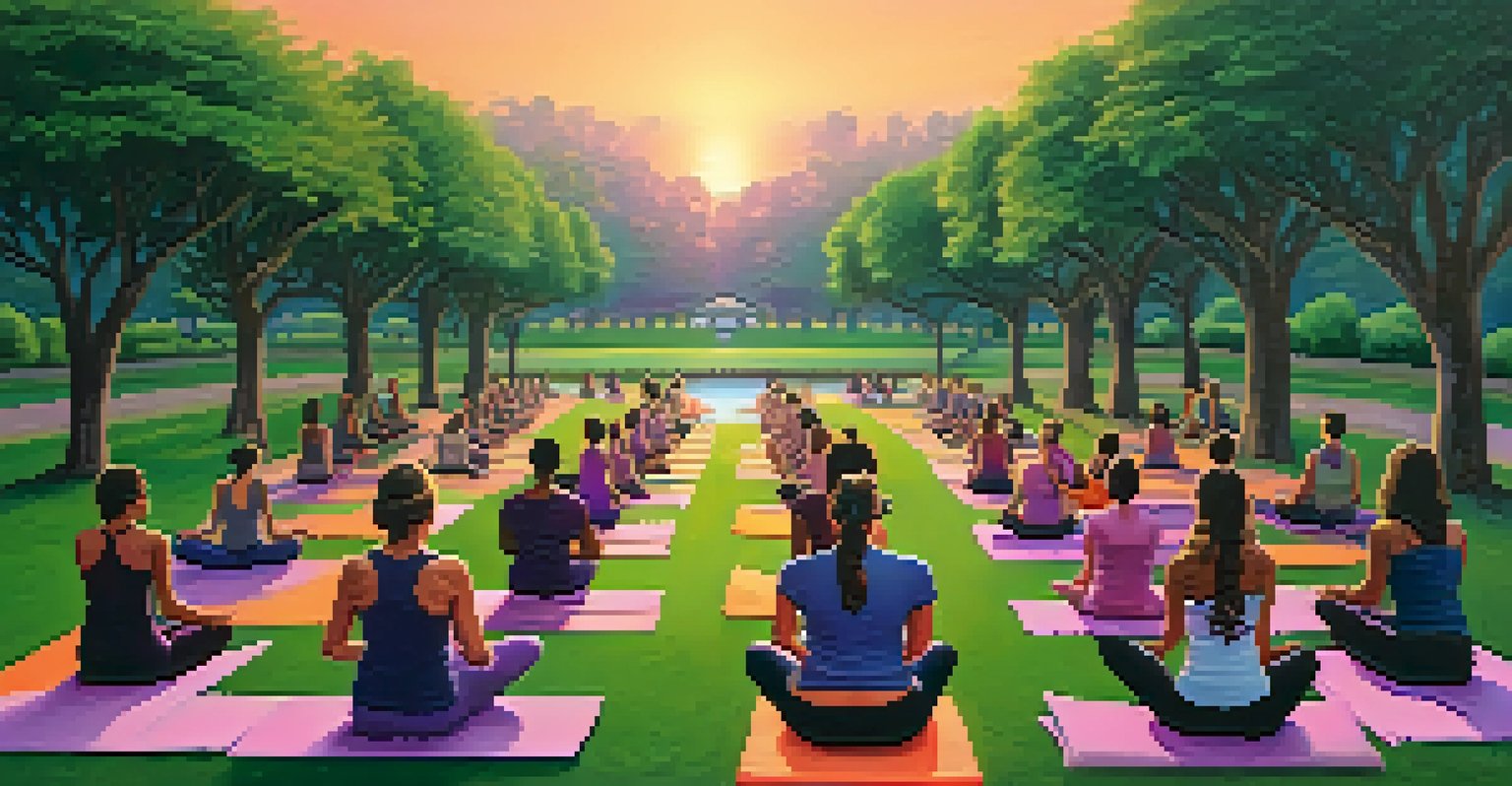Creating a Seasonal Affective Disorder Yoga Routine

Understanding Seasonal Affective Disorder (SAD)
Seasonal Affective Disorder, often referred to as SAD, is a type of depression that typically occurs during the fall and winter months when daylight hours are shorter. Many people experience symptoms like fatigue, sadness, and a lack of motivation during these darker seasons. Understanding SAD is the first step in finding effective ways to manage its impact on your life.
Yoga is the journey of the self, through the self, to the self.
The exact cause of SAD isn't fully understood, but it's believed to be related to changes in sunlight exposure, which can affect your body's internal clock and serotonin levels. Lower light levels can lead to a decrease in mood-enhancing neurotransmitters, contributing to feelings of depression. This condition affects millions of people, highlighting the need for accessible coping strategies like yoga.
Yoga offers a holistic approach to combat the symptoms of SAD, addressing both the physical and mental aspects of well-being. By incorporating specific poses and mindfulness practices, you can create a routine that nurtures your body and mind during these challenging months.
Benefits of Yoga for SAD Symptoms
Yoga is known to promote relaxation, reduce stress, and improve mood, making it an excellent tool for those dealing with SAD. The combination of physical movement, breath control, and meditation helps to boost serotonin levels and enhance overall emotional health. Plus, the practice fosters a sense of connection and community, which can be particularly beneficial when feelings of isolation set in during winter months.

Engaging in a regular yoga practice can also improve sleep quality, which is often disrupted by SAD. Better sleep leads to increased energy levels and improved mental clarity, helping you feel more equipped to tackle daily challenges. Furthermore, the physical aspect of yoga strengthens and stretches the body, combating the lethargy that often accompanies this condition.
Yoga Alleviates SAD Symptoms
Engaging in yoga promotes relaxation, improves mood, and enhances emotional health, making it a valuable practice for managing Seasonal Affective Disorder.
Moreover, yoga encourages mindfulness, allowing practitioners to become more aware of their thoughts and feelings without judgment. This increased self-awareness can empower you to navigate the emotional rollercoaster that comes with SAD, helping you cultivate a more positive mindset.
Essential Yoga Poses for Your Routine
When creating a yoga routine for SAD, it’s crucial to include poses that promote openness, grounding, and relaxation. Poses like Child’s Pose, Downward Dog, and Cat-Cow are excellent for releasing tension and calming the mind. These poses can be easily modified to suit any skill level, making them accessible for everyone, regardless of experience.
The mind is everything. What you think you become.
Incorporating heart-opening poses such as Cobra or Bridge can help to boost mood and counter feelings of sadness. These poses allow for deeper breathing and can foster a sense of emotional release, which is particularly beneficial for those experiencing SAD symptoms. Additionally, seated forward bends can promote introspection and relaxation, aiding in stress relief.
Don't forget about restorative poses like Legs-Up-the-Wall and Savasana, which are perfect for winding down. These restorative positions encourage relaxation and help to alleviate feelings of anxiety, making them vital components of your SAD yoga routine.
Incorporating Breathwork and Meditation
Breathwork, or pranayama, plays a significant role in any yoga practice, especially for those dealing with SAD. Focusing on the breath can help calm the nervous system and promote relaxation. Techniques such as deep belly breathing or alternate nostril breathing can enhance your practice, allowing you to feel more centered and at peace.
Meditation is another powerful tool to include in your routine. Even a few minutes of daily meditation can help clear your mind and reduce feelings of anxiety. Guided meditations that focus on gratitude or self-compassion can be particularly uplifting, helping to shift your mindset toward positivity during the darker months.
Importance of Consistent Practice
Establishing a regular yoga routine can help build resilience against mood fluctuations associated with SAD, providing a reliable coping mechanism during darker months.
Combining breathwork and meditation with your yoga poses creates a comprehensive approach to managing SAD. This holistic practice not only addresses physical symptoms but also nurtures your mental and emotional health, providing support throughout the season.
Creating a Consistent Yoga Schedule
Establishing a consistent yoga schedule is essential for reaping the benefits of your practice, especially when combating SAD. Aim to practice at least three to four times a week, even if it's just for 15-30 minutes. Consistency helps build a routine that your mind and body can rely on, making it easier to cope with fluctuations in mood.
Consider setting a specific time each day for your practice, whether it's in the morning to energize or in the evening to unwind. Finding a time that works best for you allows you to integrate yoga seamlessly into your daily life. You can even create a cozy space in your home dedicated to your practice, complete with your yoga mat and calming elements like candles or soft lighting.
Remember, it’s important to listen to your body and adjust your routine as needed. Some days may call for more restorative practices, while others may energize you with more vigorous flow. Flexibility in your approach will help you stay engaged and motivated throughout the season.
Finding Community Through Yoga
One of the most rewarding aspects of yoga is the sense of community it fosters. Connecting with others who share similar experiences can provide a vital support system, especially when battling SAD. Consider joining a local yoga class or participating in online sessions to broaden your network and share your journey with others.
Engaging in group practices can enhance your motivation and accountability, making it easier to stick to your routine. Plus, being part of a community can alleviate feelings of isolation, reminding you that you're not alone in your struggles. Many studios also offer workshops focused on mental health, providing additional resources to support your well-being.
Community Supports Your Journey
Connecting with others through yoga classes or online sessions fosters a supportive community that can help alleviate feelings of isolation experienced during SAD.
Involving friends or family in your yoga journey can also be beneficial. Sharing this practice with loved ones creates a shared experience, encouraging open conversations about mental health and emotional challenges. Together, you can support each other through the ups and downs of the season.
Complementing Yoga with Other Self-Care Practices
While yoga is a powerful tool for managing SAD, it's essential to complement your practice with other self-care strategies. Consider incorporating activities such as journaling, spending time outdoors, or engaging in creative hobbies that bring you joy. These practices can enhance your overall well-being, creating a well-rounded approach to combatting seasonal blues.
Nutrition also plays a crucial role in mental health. Eating a balanced diet rich in fruits, vegetables, and whole grains can help stabilize your mood and energy levels. Don't forget to stay hydrated and consider supplements like vitamin D, especially during the winter months when sunlight is scarce.

Lastly, ensure you're getting adequate rest and sleep. Prioritizing sleep hygiene, such as establishing a bedtime routine and creating a restful environment, can significantly impact your mood and energy levels. By combining yoga with a holistic self-care approach, you’re setting yourself up for success in managing SAD.